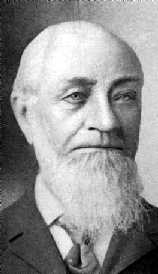William Saunders (botanist)
William Saunders (1822–1900) was a prominent Canadian botanist, pharmacist, and horticulturist who made significant contributions to agriculture and botany in Canada and the United States. He is best known for his work in plant hybridization and his leadership in various scientific and agricultural organizations.
Early Life and Education[edit | edit source]
William Saunders was born in Crediton, Devon, England in 1822. He emigrated to Canada with his family in 1833, settling in London, Ontario. Saunders showed an early interest in plants and natural sciences, which led him to pursue a career in pharmacy and later in botany and horticulture.
Career[edit | edit source]
Saunders began his career as a pharmacist but quickly shifted his focus to botany and horticulture. He was a pioneer in the field of plant hybridization in Canada, experimenting with various plant species to improve their quality and resistance to diseases. His work contributed significantly to the improvement of Canadian agriculture, particularly in the cultivation of fruits and vegetables.
In addition to his experimental work, Saunders held several important positions throughout his career. He was the founding director of the Central Experimental Farm in Ottawa, a key institution for agricultural research in Canada. Under his leadership, the farm conducted extensive research on crops, livestock, and agricultural techniques, which had a lasting impact on Canadian agriculture.
Saunders was also involved in various scientific and agricultural organizations. He was a founding member of the Entomological Society of Ontario and served as its president. He played a crucial role in the establishment of the Canadian Horticultural Society and was actively involved in the American Pomological Society.
Contributions to Botany and Horticulture[edit | edit source]
Saunders' contributions to botany and horticulture were vast. He was instrumental in introducing and developing new plant varieties, particularly fruits such as apples, pears, and grapes, which were better suited to the Canadian climate. His work in plant hybridization led to the development of several new varieties that were more resistant to diseases and had higher yields.
He also contributed to the scientific community through his publications and lectures on botany, horticulture, and agriculture. Saunders was a prolific writer, and his works were influential in spreading knowledge about plant sciences and agricultural practices in North America.
Legacy[edit | edit source]
William Saunders' legacy in the fields of botany and horticulture is significant. His pioneering work in plant hybridization and his leadership in agricultural research have had a lasting impact on Canadian agriculture. The Central Experimental Farm in Ottawa, which he helped establish, continues to be a leading center for agricultural research in Canada.
Saunders was honored for his contributions to science and agriculture during his lifetime and posthumously. He was a recipient of numerous awards and honors, and his name is commemorated in various institutions and awards within the scientific community.
Death[edit | edit source]
William Saunders passed away in 1900 in London, Ontario. His contributions to botany, horticulture, and agriculture continue to be celebrated and remembered in Canada and beyond.
Search WikiMD
Ad.Tired of being Overweight? Try W8MD's physician weight loss program.
Semaglutide (Ozempic / Wegovy and Tirzepatide (Mounjaro / Zepbound) available.
Advertise on WikiMD
|
WikiMD's Wellness Encyclopedia |
| Let Food Be Thy Medicine Medicine Thy Food - Hippocrates |
Translate this page: - East Asian
中文,
日本,
한국어,
South Asian
हिन्दी,
தமிழ்,
తెలుగు,
Urdu,
ಕನ್ನಡ,
Southeast Asian
Indonesian,
Vietnamese,
Thai,
မြန်မာဘာသာ,
বাংলা
European
español,
Deutsch,
français,
Greek,
português do Brasil,
polski,
română,
русский,
Nederlands,
norsk,
svenska,
suomi,
Italian
Middle Eastern & African
عربى,
Turkish,
Persian,
Hebrew,
Afrikaans,
isiZulu,
Kiswahili,
Other
Bulgarian,
Hungarian,
Czech,
Swedish,
മലയാളം,
मराठी,
ਪੰਜਾਬੀ,
ગુજરાતી,
Portuguese,
Ukrainian
Medical Disclaimer: WikiMD is not a substitute for professional medical advice. The information on WikiMD is provided as an information resource only, may be incorrect, outdated or misleading, and is not to be used or relied on for any diagnostic or treatment purposes. Please consult your health care provider before making any healthcare decisions or for guidance about a specific medical condition. WikiMD expressly disclaims responsibility, and shall have no liability, for any damages, loss, injury, or liability whatsoever suffered as a result of your reliance on the information contained in this site. By visiting this site you agree to the foregoing terms and conditions, which may from time to time be changed or supplemented by WikiMD. If you do not agree to the foregoing terms and conditions, you should not enter or use this site. See full disclaimer.
Credits:Most images are courtesy of Wikimedia commons, and templates Wikipedia, licensed under CC BY SA or similar.
Contributors: Prab R. Tumpati, MD

